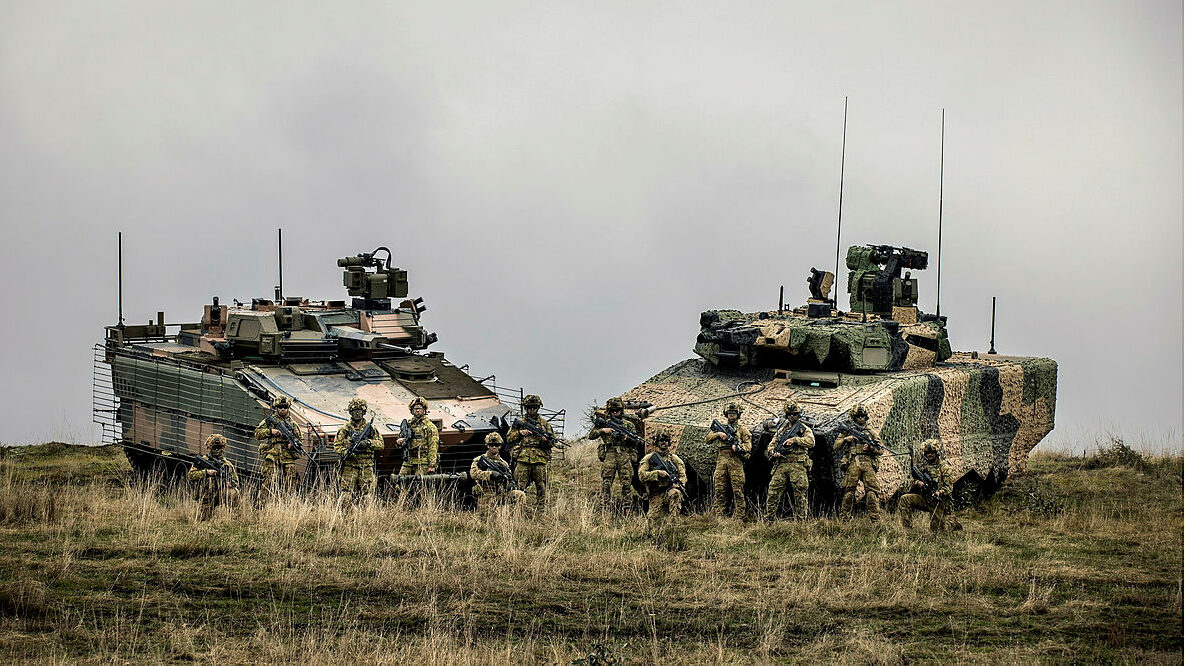
Hanwha Redback and Reinmetall Lynx (Sgt. Jake Sims for Australian Defense Ministry)
CHICAGO — Australia will slash its planned purchase of Infantry Fighting Vehicles (IFVs) from 450 to 129 as part of a broader strategic shift outlined in a highly-anticipated policy document that seems to move away from homeland defense towards power projection, with a keen eye on the major strategic challenge in the region: China.
The IFV cut is the most eye-catching, if hardly sole, procurement change to come out of the Defense Strategic Review, according to a preview viewed by Breaking Defense. An unclassified version of the document, prepared by Stephen Smith, former Labor defense minister, and Angus Houston, former chief of the defense force, will be released in Australia on Monday, their time.
The IFVs will replace the ancient M113s that Australia operates. The new tracked vehicles, designed to carry six combat equipped soldiers, are armed with 30mm cannons, remote-controlled machine guns and antitank missile launchers. The cuts, a much greater reduction in the Land 400 program than expected, leaves South Korea’s Hanwha (seen by many as the likely victor) and Germany’s Rheinmetall to juggle the fallout.
Hanwha in particular may feel some shock, as it has already invested in a plant in Geelong, Victoria to build the K9 tracked howitzer, which Australia purchased for $1 billion AUD in December 2021. But the ABC reported early this morning US time that a planned second regiment of self-propelled howitzers would not happen.
Among the other acquisition changes:
• LAND 8710 Phases 1-2 – Army Landing Craft should be accelerated and expanded.
• LAND 8113 Phases 2-4 – Long-Range Fires (HiMARS) should be accelerated and expanded.
• LAND 4100 Phase 2 – Land-Based Maritime Strike should be accelerated and expanded.
Prime Minister Anthony Albanese has hinted that changes were coming for several months. In November, Albanese that Australia would look to prioritize missiles, missile defense capabilities and drones, including armed drones. He appeared to ridicule the basic tenet of the army’s argument that armor will be needed to defend the Australia landmass, known generically as the “northern strategy” since the assumption was that no one could possibly move many forces to attack the island continent’s soft underbelly.
“Are we going to be involved in a land war in central Queensland? Is that likely? Well, no,” Albanese said.
Of course, all strategy documents are also political documents, and this review appears no different. In information shared with reporters, the government places blame on the previous regime of former Prime Minister Scott Morrison for declaring it would spend money for which it had not budgeted. As of August 2022, the defense budget was over-programed by 24 percent for acquisitions, according to information obtained by Breaking Defense. All in all, the previous government announced $42 billion in spending over the decade to 2032-33 without allocating money for it, per the Albanese team.
That included at least $8 billion in new cyber spending for the Australian Signals Directorate. Dubbed Project REDSPICE for Resilience, Effects, Defence, Space, Intelligence, Cyber, and Enablers, the Australian government said in March last year that it was the “largest ever investment” in the capabilities of the ASD, the Aussie version of the National Security Agency.
The Morrison government also committed to $32.2 billion for its Guided Weapons and Explosive Ordnance Enterprise and $1.9 billion for the AUKUS Pillar 2.
The statement from the government said they won’t know the full cost of the Defense Strategic Review’s recommendations until the Department of Defense has analyzed the capability recommendations and figured out how much they will cost.
But hard choices will have to be made. The government said some projects should be immediately delayed, reduced or canceled.






















